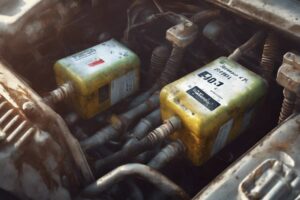When dealing with the P0445 code related to the EVAP system purge control valve circuit, start by checking for a short circuit. Inspect wiring thoroughly for potential electrical faults.
Use voltage testing to pinpoint the exact location of the short. Confirm the purge valve functions properly for the EVAP system to work correctly. Faulty purge control valves or solenoids can trigger the P0445 code.
Secure the gas cap tightly to prevent triggering the code. Evaluate fuel line integrity for breaks or leaks. Carefully examine wiring and connections for tightness and corrosion to troubleshoot effectively.
Understanding these steps is crucial in resolving the P0445 code.
Key Points
- Conduct voltage testing to pinpoint the short circuit location in the purge control valve circuit.
- Use a smoke machine for a thorough evaluation of the EVAP system’s integrity.
- Inspect wiring, purge control valve, and gas cap for visible damage.
- Utilize an OBD-II scanner to retrieve specific trouble codes related to the EVAP system.
- Identifying leaks in the system and ensuring secure connections are crucial for troubleshooting.
P0445 Code Definition

Understanding the P0445 code is essential for diagnosing issues with your vehicle’s EVAP system.
This code points to a short circuit in the evaporative emission control system purge control valve circuit.
To address this, you need to conduct a thorough wiring inspection to identify any potential electrical faults.
Voltage testing is important to pinpoint the exact location of the short circuit and determine the extent of the issue.
Also, it’s important to evaluate the purge valve functionality. The purge valve plays a key role in the EVAP system, ensuring that fuel vapors are properly routed and burned in the engine.
A malfunctioning purge valve can lead to issues such as poor fuel efficiency and increased emissions. By testing the purge valve’s operation, you can determine if it’s working correctly or if it needs to be replaced.
Proper diagnosis and repair of these components are essential for resolving the P0445 code and restoring your vehicle’s EVAP system to efficient functionality.
Common Causes of P0445 Code
To identify the common causes of the P0445 trouble code, inspect the purge control valve and solenoid for faults. When troubleshooting the P0445 code, consider the following possible culprits:
- Faulty Purge Control Valve or Solenoid: A malfunction in these components is a primary trigger for the P0445 trouble code.
- Securely Fasten Gas Cap: Make sure the gas cap is securely fastened, as a loose or faulty cap is a frequent cause of the P0445 diagnostic trouble code.
- Breaks in the Fuel Line: Check for any breaks or leaks in the fuel line within the evaporative fuel system, as they can lead to the P0445 code.
- Examine Wiring for Tightness or Corrosion: Examine the electrical connections around the purge control valve circuitry for any looseness or corrosion, as this may cause the P0445 trouble code.
Symptoms of P0445 Code

Inspecting the symptoms of the P0445 code reveals that it typically manifests with minimal noticeable indicators apart from the illumination of the Check Engine light.
However, identifying leaks in the evaporative emission control system and testing connections can help diagnose the issue.
The P0445 code mainly alerts you to a potential short circuit in the purge control valve circuit.
While there may not be obvious signs like strange noises or performance issues, addressing this code promptly is vital to prevent negative impacts on emissions and fuel efficiency.
By focusing on identifying leaks within the system and ensuring connections are secure, you can effectively troubleshoot the P0445 code.
Remember, even though the symptoms may be subtle, taking action to resolve this issue is essential for the overall health and performance of your vehicle.
Stay attentive to any potential leaks and conduct thorough testing to pinpoint the root cause of the problem.
Diagnosing P0445 Code
When troubleshooting the P0445 code, pinpointing the short circuit in the evaporative emission control system purge control valve circuit is crucial. To diagnose the issue effectively, consider the following steps:
- Voltage Testing: Utilize a voltmeter to check the voltage levels in the purge control valve circuit. Look for any irregularities that could indicate a short circuit.
- Smoke Testing: Employ a smoke machine to evaluate the integrity of the EVAP system. By introducing smoke into the system, you can identify potential leaks that might be causing the P0445 code.
- Visual Inspection: Examine the purge control valve, wiring, and gas cap for any visible signs of damage or wear. Make sure all connections are secure and free from corrosion.
- OBD-II Scanner: Use an OBD-II scanner to retrieve specific trouble codes and data related to the EVAP system. This information can help pinpoint the exact source of the short circuit.
Can Error Code P2097 Affect the EVAP System Purge Control Valve Circuit?
Yes, error code P2097 can affect the EVAP system purge control valve circuit. When this code appears, it indicates a problem with the fix post catalyst fuel trim. It can lead to issues with the EVAP system and cause the purge control valve circuit to malfunction. It’s important to address this error promptly.
Are EVAP system and cylinder deactivation system related in a car’s engine?
Yes, the EVAP system and navigating cylinder deactivation system are both crucial components of a car’s engine. While the EVAP system deals with controlling emissions, the navigating cylinder deactivation system is responsible for optimizing fuel efficiency by deactivating select engine cylinders during low-load driving conditions.
Can an Overboost Condition Code Cause Issues with the EVAP System Purge Control Valve Circuit?
When it comes to the EVAP system purge control valve circuit, it’s important to consider potential issues such as decoding the P0234 overboost condition. This specific code could potentially cause problems with the EVAP system, so it’s crucial to address this issue promptly to maintain optimal functionality.
Repairing P0445 Code

Start by addressing the P0445 code with a thorough examination of the evaporative emission control system components. Begin by checking the wiring connections to confirm there are no loose or damaged wires.
Inspect the purge control valve and solenoid for any signs of wear or malfunction. If any components show faults, consider replacing them to rectify the issue.
Tighten or replace the fuel filler cap if it’s loose or damaged, as this can also trigger the P0445 code. Make sure that all connections are securely fastened to prevent any short circuits.
Importance of Resolving P0445 Code
To guarantee excellent performance and prevent further issues with your vehicle, addressing the P0445 code promptly is essential. Here’s why resolving the P0445 code is important:
- Performance Impact: Ignoring the P0445 code can lead to decreased fuel efficiency and engine performance. Resolving it ensures your vehicle operates at its best.
- Environmental Consequences: Failure to address the P0445 code can result in increased harmful emissions, contributing to environmental pollution. Resolving it helps reduce your carbon footprint.
- Prevention of Further Damage: Promptly addressing the P0445 code can prevent potential harm to other components in the EVAP system, saving you from more extensive repairs in the future.
- System Functionality: Resolving the P0445 code ensures the proper functioning of the evaporative emission control system, maintaining your vehicle’s overall efficiency and compliance with emission regulations.
As an Amazon Associate we earn from qualifying purchases.










